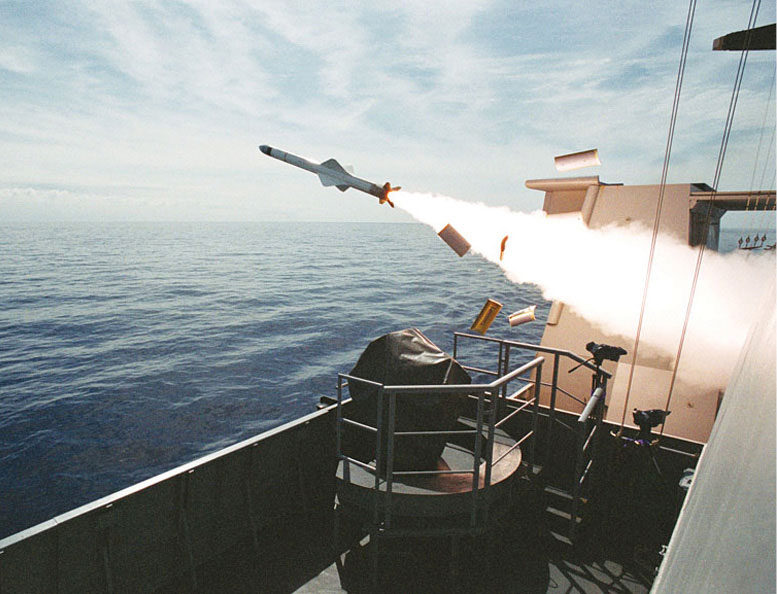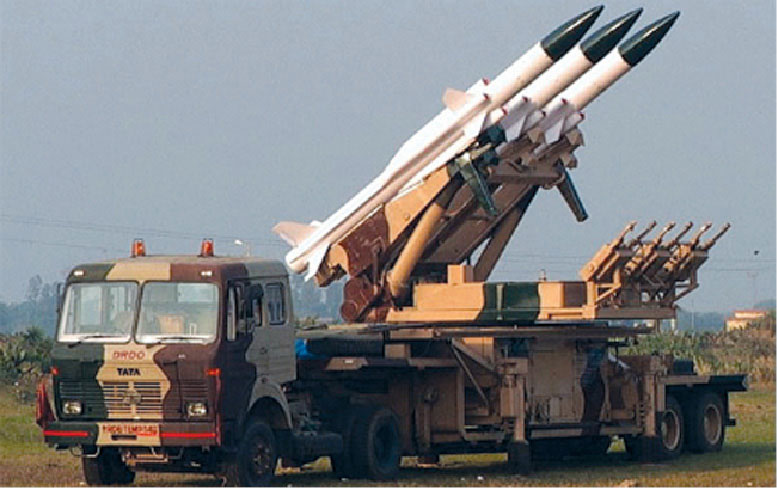Its capabilities include look-down, shoot-down, multiple launches against multiple targets and intercepts at very short range in dogfight situations. It was inducted into service in 1991 and is in service till date with the US Air Force and Navy and more than 25 allies of the USA.
RIM-174 Standard extended-range active-missile (ERAM), also called Standard Missile 6 (SM-6), is a long-range anti-air-warfare missile designed for use by the navy against a range of aerial targets including fixed and rotary wing aircraft, unmanned aerial vehicles, low-attack cruise missiles and anti-ship cruise missiles in flight to provide area and ship defence (Fig. 7).
RIM-174 Standard ERAM meets the need for a vertically-launched, extended-range missile compatible with AEGIS weapon system to be used against extended-range threats.
The missile is also capable of terminal ballistic defence as a supplement to RIM-161 (SM-3). Its design is adapted from RIM-156A (also called SM-2ER), an earlier missile of the Standard missile family. It is a two-stage missile with a booster stage and a second stage.
An addition to the hardware is the active radar homing seeker derived from the seeker used in AIM-120C AMRAAM missile. The active radar seeker gives it the capability to engage highly-agile targets and also targets that are beyond the effective range of the launch vessels’ target illumination radars.
The missile has a maximum operational range of 240km with a maximum cruise speed of greater than 3.5Mach. The system is a combination of inertial guidance, semi-active and active radar homing guidance.
The missile may be employed in a number of modes: inertial-guided to target with terminal acquisition using active radar seeker, semi-active radar homing all the way or an over-the-horizon shot with cooperative engagement capability. The missile was inducted into service in 2013 and is in use by the US Navy, Royal Australian Navy and Republic of Korea Navy.
EXOCET family of missiles, currently manufactured by MBDA, France, are anti-ship, sea-skimming missiles. Different variants of this family have operational ranges of 70km to 180km and can be launched from surface vessels, submarines, helicopters and fixed-wing aircrafts.
EXOCET MM-40 series is the latest in the family of EXOCET missiles, with EXOCET MM-40 Block-3 being the most recent missile in EXOCET MM-40 series. Salient features of EXOCET MM-40 Block-3 missile include effective operational range of 180km, anti-ship as well as littoral operations and land-attack capability, automatic computation of engagement plans to support firing decisions and a sophisticated navigation package comprising hybrid INS/GPS and a radar altimeter and an advanced J-band active radar seeker for terminal guidance.


EXOCET missile was inducted in service in 1973, beginning with the air-launched version. It was inducted in the US Navy in 1979. The USA’s Harpoon, Swedish RBS-15 and Chinese Yingji are its main competitors.
It is in use by a large number of countries including India, France, Germany, Greece, Iran, South Africa, South Korea, Pakistan, Indonesia, Turkey and Malaysia. Indian Navy uses it on the scorpene class of submarines.
Akash, developed by India’s state-owned Defence Research and Development Organisation (DRDO) and manufactured by Ordnance Factories Board, Bharat Dynamics and Bharat Electronics, is an all-weather, medium-range surface-to-air missile system with target intercept range of 30k to 35km at altitudes up to 18km.
The missile can be launched from static as well as mobile platforms including wheeled trucks and battle tanks. It is capable of handling multiple targets and destroying manoeuvring targets such as unmanned aerial vehicles, cruise missiles and fighter aircraft. It can carry conventional and nuclear warheads weighing up to 60kg.
The complete system comprises a launcher, missiles, control centre, an integral mission guidance system, multifunctional fire control radar, system arming and explosion mechanism, digital autopilot, C4I (command, control communication and intelligence) centres and supporting ground equipment. Each Akash launcher has three missiles (Fig. 9).The missile was inducted into service in 2009 and is in use by Indian Air Force and Indian Army.
Radar-guided missiles of the future will have enhanced capabilities, particularly in terms of their guidance systems so as to improve kill probability and make these practically a single-shot kill weapon.
One such futuristic missile that will incorporate these features is K-77M from Russia, which aims to frustrate any missile evasion maneuvers enabling a target to escape. The missile would get this feature with a major innovation of K-77M guidance system. The active radar guidance system in the nose of the missile will have its own active phased array antenna (APAA) due to which the missile will have zero reaction time to unexpected manoeuvres of the target aircraft. The missile is expected to be delivered by 2017.










